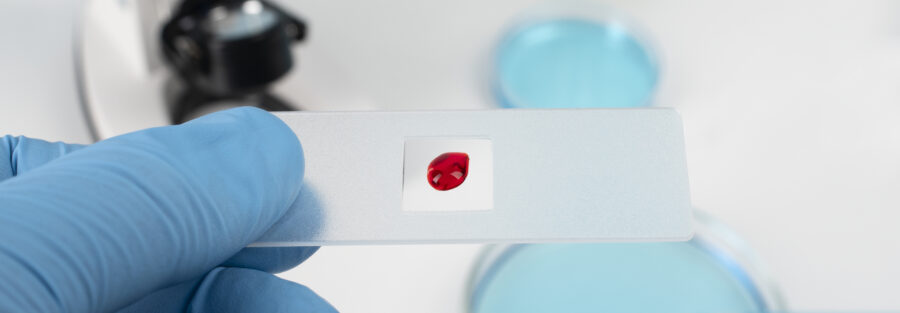“I just got my check-up results, and my platelets are really low. Should I be worried about a hemorrhage?”
“I don’t feel anything, and my family doctor has already checked me for signs of hemorrhage, but my platelets are still low.”
Introduction
Many patients are alarmed when they receive blood test results indicating a low platelet count, fearing an increased risk of bleeding. However, in some cases, this finding does not reflect a true medical condition but rather a laboratory artefact known as pseudothrombocytopenia (PTCP). PTCP results from platelet clumping in ethylenediaminetetraacetic acid (EDTA)-treated blood samples, leading automated analysers to produce falsely low platelet counts. Recognising PTCP is crucial to avoid unnecessary medical interventions, including unwarranted treatments and invasive procedures.
What is Pseudothrombocytopenia?
PTCP is a misrepresentation of platelet levels in blood tests rather than an actual deficiency of platelets in the bloodstream. Unlike true thrombocytopenia, which can cause symptoms such as bruising, gum bleeding, and nosebleeds, PTCP is entirely asymptomatic. The erroneous readings occur due to platelet clumping, which reduces the apparent platelet count in automated analyses. As a result, misdiagnosis can lead to unnecessary treatments and unwarranted medical procedures.
Identifying Pseudothrombocytopenia
PTCP can typically be diagnosed using several approaches:
- Peripheral Blood Smear (PBS) Examination: A manual review of the blood sample can reveal platelet aggregates, confirming PTCP and ruling out genuine thrombocytopenia.
- Alternative Anticoagulants: Using citrate or heparin instead of EDTA for blood collection can prevent platelet clumping and provide an accurate platelet count.
- Maintaining Sample Temperature: Keeping blood samples at approximately 37°C can minimize platelet aggregation.
- Fluorescence Platelet Counting and Flow Cytometry: These advanced techniques can provide a more accurate platelet count when necessary.
- Rapid Analysis: Analysing blood samples shortly after collection can prevent time-dependent platelet clumping, reducing the likelihood of PTCP misdiagnosis.
Risk Factors and Associated Conditions
Although PTCP is not linked to any specific disease, it is more frequently observed in hospitalised patients and individuals with autoimmune disorders. Other risk factors include pregnancy, infections, cardiovascular diseases, liver disease, and the use of certain medications such as low-molecular-weight heparin (LMWH), antibiotics, and chemotherapy agents. Despite these associations, PTCP itself does not indicate an increased risk of developing any medical condition.
Mechanisms of Platelet Clumping and Cross-Reactivity in PTCP
The phenomenon of Platelet-Targeted Cold Agglutinin (PTCP) was first described by Gowland et al. in 1969 in a patient with malignant non-Hodgkin’s lymphoma. Initially recognised as an in vitro occurrence, further studies revealed that PTCP could also be observed in healthy individuals without a significant bleeding phenotype.
Research has shown that cold agglutinins and antinuclear antibodies are more frequently present in individuals with PTCP compared to healthy controls. In 1981, Manthorpe et al. reported anti-platelet antibody activity, observed through immunofluorescence experiments using Fab’2 fragments of isolated IgG. Subsequent studies confirmed the diverse origins of these antibodies, including various immunoglobulin classes, primarily IgG (especially IgG1), sometimes alongside IgA and IgM. These antibodies can either be naturally occurring autoantibodies or acquired ones.
It is suggested that these autoantibodies target cryptic epitopes of the GpIIbIIIa complex (a calcium-dependent fibrinogen receptor), or negatively charged phospholipids. This interaction is thought to lead to in vitro platelet agglutination following tyrosine kinase activation. Other immune complexes, interacting with Fc receptors on the platelet surface, may also contribute to the PTCP process.
Additionally, spurious thrombocytopenia can occur due to platelet satellitism around white blood cells. While this is commonly observed with neutrophils, it is less frequently seen around lymphocytes.
The most widely accepted hypothesis is that PTCP is driven by antibody production due to cross-reactivity or by autoimmune antibodies, as discussed above. The detection of platelet-bound GpIIbIIIa antibodies in 80% of cases further supports this theory.
Consequences of Misdiagnosis: Mistreatment and Over-Treatment
Failure to recognise PTCP can lead to inappropriate clinical decisions:
- Misdiagnosis as Immune Thrombocytopenia (ITP): PTCP is often mistaken for ITP, an autoimmune disorder that requires steroid or immunoglobulin therapy. Unnecessary immunosuppression can expose patients to infections and metabolic disturbances.
- Unnecessary Platelet Transfusions: Patients with falsely low platelet counts may receive unwarranted transfusions, leading to risks such as transfusion reactions and alloimmunization.
- Invasive Procedures: Misdiagnosis can lead to unnecessary bone marrow biopsies, subjecting patients to discomfort and avoidable risks.
- Hospitalisation and Medication Errors: Some patients are unnecessarily admitted for monitoring or have their anticoagulation therapy incorrectly adjusted, increasing the risk of thrombosis.
Management of Pseudothrombocytopenia (PTCP)
Effective management of PTCP hinges on accurate diagnosis, careful differentiation from true thrombocytopenia, and ensuring that patients are not subject to unnecessary or excessive treatment. The primary goal in managing PTCP is to correctly identify the condition and distinguish it from other causes of low platelet counts.
The following steps are recommended for optimal management:
- Repeat Testing with Alternative Anticoagulants: Blood samples should be re-evaluated using citrate or heparin as anticoagulants, as platelet clumping predominantly occurs in EDTA-treated samples.
- Peripheral Blood Smear Examination: A manual examination of the peripheral smear can reveal platelet aggregates, confirming the diagnosis of PTCP and ruling out genuine thrombocytopenia.
- Flow Cytometry and Optical Platelet Counting: These techniques can be utilised when necessary to confirm the diagnosis, particularly in cases where there is uncertainty.
- Patient Education and Documentation: It is essential to educate patients with PTCP about their condition to alleviate undue concerns and ensure that future healthcare providers are informed of the diagnosis.
As PTCP does not present a risk of bleeding, treatment is generally unnecessary. The primary focus of management is to avoid misdiagnosis and the subsequent risk of inappropriate treatment.
The Future: AI in Pseudothrombocytopenia Detection
While artificial intelligence (AI) has been increasingly applied to haematology, research on AI specifically in PTCP remains limited.
The application of AI in pseudothrombocytopenia is largely speculative at this stage, but future research could focus on developing algorithms that:
- Detect Anomalies: Identify irregularities in blood test results that suggest pseudothrombocytopenia.
- Improve Diagnostic Accuracy: Enhance the precision of platelet counts by integrating AI with advanced laboratory techniques.
- Predictive Modelling: Develop models to predict the likelihood of pseudothrombocytopenia based on patient and sample characteristics.
Conclusion
Pseudothrombocytopenia is a laboratory artefact that must be accurately identified to prevent unnecessary medical interventions. By utilising proper diagnostic techniques, healthcare professionals can avoid mistreatment and over-treatment of patients with falsely low platelet counts. As AI continues to advance in medical diagnostics, it may play a significant role in refining PTCP detection and minimising errors in platelet count assessments.
List of references:
- Irfan Yavasoglu, Bilal Acar, Gurhan Kadikoylu, Zahit Bolaman, Platelet Aggregation Tests Are Affected in Pseudothrombocytopenia, Laboratory Medicine, Volume 41, Issue 8, August 2010, Pages 483–485, https://doi.org/10.1309/LM9UXAORTFONZ6U5
- Bizzaro, Nicola. Pathology – Journal of the RCPA: 2009 – Volume 41 – Issue – p 34
- Blood 2011; 117 (16): 4168. doi: https://doi.org/10.1182/blood-2010-09-295212
- Dániel Bereczki, Béla Nagy, Adrienne Kerényi, Gábor Nagy, Krisztina Szarka, Katalin Kristóf, Balázs Szalay, Barna Vásárhelyi, Harjit P Bhattoa, János Kappelmayer, EDTA-Induced Pseudothrombocytopenia up to 9 Months after Initial COVID-19 Infection Associated with Persistent Anti-SARS-CoV-2 IgM/IgG Seropositivity, Laboratory Medicine, Volume 53, Issue 2, March 2022, Pages 206–209, https://doi.org/10.1093/labmed/lmab050
- MedicalNewsToday: What is Pseudothrombocytopenia; reviewed February 25, 2020.
- Lardinois B, Favresse J, Chatelain B, Lippi G, Mullier F. Pseudothrombocytopenia-A Review on Causes, Occurrence and Clinical Implications. J Clin Med. 2021 Feb 4;10(4):594. doi: 10.3390/jcm10040594. PMID: 33557431; PMCID: PMC7915523.
- Papakitsou I, Papazachariou A, Filippatos TD, Ioannou P. Incidence, Risk Factors, and Outcomes of Thrombocytopenia in Older Medical Inpatients: A Prospective Cohort Study. Hematology Reports. 2024; 16(4):804-814. https://doi.org/10.3390/hematolrep16040076
- Johan Slotman, Maurice Swinkels, Petra E. Burgisser, Joyce Bestebroer, Thomas R.L. Klei, Adriaan B. Houtsmuller, Frank W.G. Leebeek, Ruben Bierings, A.J. Gerard Jansen; Predicting Platelet Age Using Artificial Intelligence Techniques. Blood2022; 140 (Supplement 1): 2656–2657. doi: https://doi.org/10.1182/blood-2022-159033
- Tavakkoli Shiraji S, Sanaei M. The application of artificial intelligence (AI) in the diagnosis of platelet disorders. Iranian Journal of Blood and Cancer 2023; 15 (3) :68-83
- Elshoeibi AM, Ferih K, Elsabagh AA, Elsayed B, Elhadary M, Marashi M, Wali Y, Al-Rasheed M, Al-Khabori M, Osman H, Yassin M. Applications of Artificial Intelligence in Thrombocytopenia. Diagnostics (Basel). 2023 Mar 10;13(6):1060. doi: 10.3390/diagnostics13061060. PMID: 36980370; PMCID: PMC10047875.


